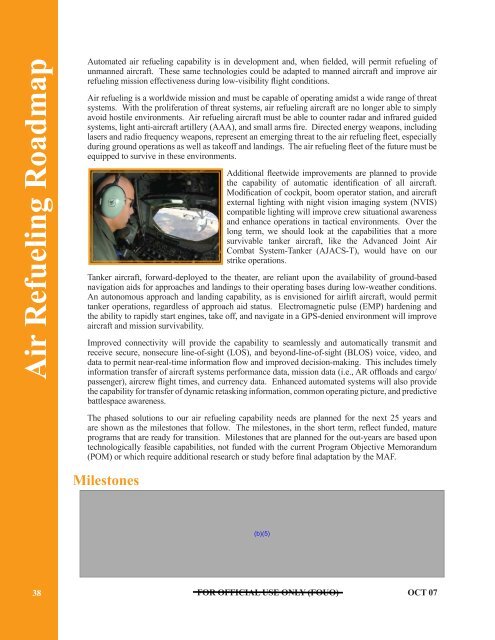Air Mobility Plan, 2008 - The Black Vault
Air Mobility Plan, 2008 - The Black Vault
Air Mobility Plan, 2008 - The Black Vault
You also want an ePaper? Increase the reach of your titles
YUMPU automatically turns print PDFs into web optimized ePapers that Google loves.
<strong>Air</strong> Refueling Roadmap<br />
Automated air refueling capability is in development and, when fielded, will permit refueling of<br />
unmanned aircraft. <strong>The</strong>se same technologies could be adapted to manned aircraft and improve air<br />
refueling mission effectiveness during low-visibility flight conditions.<br />
<strong>Air</strong> refueling is a worldwide mission and must be capable of operating amidst a wide range of threat<br />
systems. With the proliferation of threat systems, air refueling aircraft are no longer able to simply<br />
avoid hostile environments. <strong>Air</strong> refueling aircraft must be able to counter radar and infrared guided<br />
systems, light anti-aircraft artillery (AAA), and small arms fire. Directed energy weapons, including<br />
lasers and radio frequency weapons, represent an emerging threat to the air refueling fleet, especially<br />
during ground operations as well as takeoff and landings. <strong>The</strong> air refueling fleet of the future must be<br />
equipped to survive in these environments.<br />
Additional fleetwide improvements are planned to provide<br />
the capability of automatic identification of all aircraft.<br />
Modification of cockpit, boom operator station, and aircraft<br />
external lighting with night vision imaging system (NVIS)<br />
compatible lighting will improve crew situational awareness<br />
and enhance operations in tactical environments. Over the<br />
long term, we should look at the capabilities that a more<br />
survivable tanker aircraft, like the Advanced Joint <strong>Air</strong><br />
Combat System-Tanker (AJACS-T), would have on our<br />
strike operations.<br />
Tanker aircraft, forward-deployed to the theater, are reliant upon the availability of ground-based<br />
navigation aids for approaches and landings to their operating bases during low-weather conditions.<br />
An autonomous approach and landing capability, as is envisioned for airlift aircraft, would permit<br />
tanker operations, regardless of approach aid status. Electromagnetic pulse (EMP) hardening and<br />
the ability to rapidly start engines, take off, and navigate in a GPS-denied environment will improve<br />
aircraft and mission survivability.<br />
Improved connectivity will provide the capability to seamlessly and automatically transmit and<br />
receive secure, nonsecure line-of-sight (LOS), and beyond-line-of-sight (BLOS) voice, video, and<br />
data to permit near-real-time information flow and improved decision-making. This includes timely<br />
information transfer of aircraft systems performance data, mission data (i.e., AR offloads and cargo/<br />
passenger), aircrew flight times, and currency data. Enhanced automated systems will also provide<br />
the capability for transfer of dynamic retasking information, common operating picture, and predictive<br />
battlespace awareness.<br />
<strong>The</strong> phased solutions to our air refueling capability needs are planned for the next 25 years and<br />
are shown as the milestones that follow. <strong>The</strong> milestones, in the short term, reflect funded, mature<br />
programs that are ready for transition. Milestones that are planned for the out-years are based upon<br />
technologically feasible capabilities, not funded with the current Program Objective Memorandum<br />
(POM) or which require additional research or study before final adaptation by the MAF.<br />
Milestones<br />
(b)(5)<br />
38<br />
FOR OFFICIAL USE ONLY (FOUO)<br />
OCT 07
















